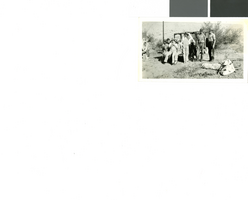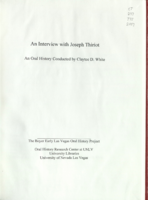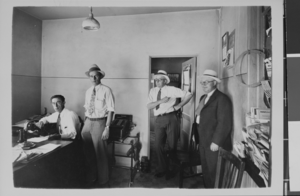Search the Special Collections and Archives Portal
Search Results
Valda and Esper Esau oral history interview
Identifier
Abstract
Oral history interview with Valda and Esper Esau conducted by Su Kim Chung on February 20, 2014 for the Boyer Early Las Vegas Oral History Project. In this interview, the Espers discuss their careers in entertainment. Valda Esper begins by describing her upbringing in Australia, learning to dance, and later going on to perform in various productions in Paris, France, as well as other European countries, before moving to Las Vegas, Nevada in 1958 to perform as a showgirl at the Stardust Resort and Casino. Esper Esau then describes his personal history, how he developed stage hand experience, moving to Las Vegas in 1954, and working shows with prominent performers, such as Liberace, Frank Sinatra, and Dean Martin. Esper continues, describing his specific job duties and why he transferred to the Stardust from the Sands Hotel & Casino. Valda discusses the life of a Las Vegas showgirl, the amount of work the position required, and how they were required to present themselves in public. The Espers recall how they met, life in Las Vegas during the 1960s, and opening a bed and breakfast after retiring from show business.
Archival Collection
James A. "Jimmy" Gay III oral history interview
Identifier
Abstract
Oral history interview with James A. (Jimmy Gay) Gay III conducted by Joyce M. Wright in 1973 for the Ralph Roske Oral History Project on Early Las Vegas. In this interview, Gay recalls details about his education in Arkansas and his training in mortuary science in Chicago, Illinois and discusses the nine-year delay in obtaining his license to practice as a mortician in Nevada because of racial discrimination. He recounts his move to Las Vegas, Nevada in 1946, his experiences as a recreation director and as a personnel and communications director for the hotel industry, work that he took while waiting for his licensure to practice. He also talks about his career as a mortician with Palm Mortuary in Las Vegas, the atomic testing of the 1950s and 1960s, and his long involvement with the NAACP and the Freedom Fund. He closes by reciting two poems that have inspired him and express his philosophy.
Archival Collection

Photograph of people camping in Moapa, Nevada, circa 1920s to 1940s
Date
Archival Collection
Description
Image

Patricia Lappin interview, February 26, 1980: transcript
Date
Archival Collection
Description
From the Ralph Roske Oral History Project on Early Las Vegas collection OH-01063. On February 26, 1980, Nancy Bright interviewed school teacher, Patricia Lappin (born April 14th, 1924 in Denver, Colorado) at Robert L. Taylor Elementary School in Henderson, Nevada. The interview covers Boulder City, Nevada around Hoover Dam. The two discuss the different gambling habits between Southern Nevada locals and Las Vegas tourists. During the latter half of the interview, the two speak at length about the impact of nuclear waste on Nevada. Lappin explains the unique issues that Southern Nevada faces as one of three states to accept nuclear waste.
Text
Patricia Lee oral history interview
Identifier
Abstract
Oral history interview with Patricia Lee conducted by Stefani Evans and Claytee White on September 19, 2023 for the Boyer Early Las Vegas Oral History Project. Lee begins the interview by discussing her childhood in Daegu, South Korea, born to a Black American father and a Korean mother. Patricia Lee arrived in the United States with her parents as a young child when the U.S. Air Force transferred her father to Vandenburg Air Force Base in California. Lee was seven when her father left. With her mother speaking no English, Lee was responsible for her family's food stamps and social services even as they endured serial evictions and homelessness that included a stay in a shelter for abused women. In middle school, Upward Bound was Lee's "game-changer." As she had in high school, Lee immersed herself in student life and academics at the University of Southern California, while also working several jobs. After graduation, she worked at the California Science Center Museum before entering law school at George Washington University. She graduated in May 2002, shortly after the legal profession had lost several top law firms that had been headquartered in New York City's Twin Towers. When she accepted an offer from Las Vegas firm Hutchison & Steffen, she became the firm's first woman attorney and first attorney of color; seven years later, she became the firm's first woman partner and first partner of color. Lee was appointed to the bench of the Supreme Court of Nevada in November 2022 by Governor Steve Sisolak.
Archival Collection
Dr. John Fildes oral history interviews
Identifier
Abstract
Oral history interviews with Dr. John Fildes conducted by Claytee D. White on June 10, 2021 and April 12, 2022 for the Boyer Early Las Vegas Oral History Project. Dr. John Fildes is Professor and Inaugural Chair of the Department of Surgery at the Kirk Kerkorian School of Medicine at the University of Nevada Las Vegas (UNLV). Fildes graduated from the University of Santo Tomas Faculty of Medicine and Surgery in Manila, Philippines in 1982. Upon returning to the United States, he completed his residency in General Surgery at the Bronx-Lebanon Hospital in the South Bronx and a fellowship in Trauma, Burns, and Surgical Critical Care in Cook County. In 1995, Fildes was hired to come to Las Vegas, Nevada by Dr. Dale Harrison. Fildes instituted policies and procedures that proved to be effective when the 1 October shooting occured in 2017. All those alive upon arrival to University Medical Center (UMC) survived. Dr. Fildes and his team used all their skills, strategies, and medical acumen to ensure those results. In the second interview, Dr. Fildes continues his history by shared thoughts about the COVID-19 pandemic and his experiences with various governmental and military assignments, including the military tradition of passing the challenge coins as a token of admiration. Finally, Fildes concludes his interviews by noting that COVID was all-consuming and tested the balance between individual rights and public health.
Archival Collection
Don Payne with Joe Buck and Don English oral history interview
Identifier
Abstract
Oral history interview with Don Payne, Joe Buck, and Don English conducted by Perry Kaufman on November 25, 1972 for the Ralph Roske Oral History Project on Early Las Vegas. Payne, the head of the Las Vegas News Bureau, relates moving to Las Vegas, Nevada as a child, and deciding on a career in advertising and marketing. He talks about his early career and the history of the bureau. Later, Buck and English, both photographers with the bureau, join Payne in discussing the goals of the the organization. They relate the need to establish that Las Vegas was more than gambling and how their marketing and photographs focus on the relaxing, fun, and luxurious aspects of a vacation in the area. They talk about the large volume of photographs produced by the bureau and the success of some nationwide, including the "floating craps table" and the atomic bomb test mushroom cloud framed between two casinos in downtown Las Vegas. They conclude by discussing how they have expanded their marketing to include destinations close to Las Vegas, including Lake Mead, the National Parks, and California destinations within "a day's drive".
Archival Collection
Tony Grasso and Doug Charles oral history interview
Identifier
Abstract
Oral history interview with Tony Grasso and Doug Charles conducted by Coleen Seifert on February 29, 1980 and March 01, 1980 for the Ralph Roske Oral History Project on Early Las Vegas. Grasso first provides details on his background and how he ended up moving to Las Vegas, Nevada in 1951 before talking about his experience as a dealer in some of the early casinos. Grasso then talks about issues and controversies related to the gaming unions, the Nevada Gaming Control Board, and his then-current work at the Aladdin casino. Doug Charles discusses his career in the gaming industry. Charles also talks about his family background, his arrival to Las Vegas in 1957, and the early development of the various gaming properties in Las Vegas. He later goes into detail over some of his experiences as a dealer, his opinions on mob control over gaming, and some of the political and legal issues that have arisen in Las Vegas gaming.
Archival Collection

Transcript of interview with Joseph Thiriot by Claytee White, August 10, 2000
Date
Archival Collection
Description
Joseph Thiriot is a longtime Las Vegas resident who served the community as an educator. He was born in 1906 in Provo, Utah; one of five sons bom to George W. and Elvira Thiriot. He has vivid memories of moving about, including living in Idaho where his father sold a typing machine , a forerunner to the typewriter. Eventually the family moved to a ranch in Pahranagat Valley, Nevada, where the limits of educational opportunities compelled his paients to send him back to Provo to finish his education while living with family there. Gaining a teaching certificate enabled Joseph to teach in rural Nevada. He completed his degree at the University of Utah and after meeting Las Vegas Superintendent Maude Frazier he relocated to Las Vegas to become a teacher. He reminisces about his life and the changes that have occurred over the years in Las Vegas.
Text

Photograph of possibly the Cashman office, Las Vegas, circa mid 1900s
Date
Archival Collection
Description
Image
